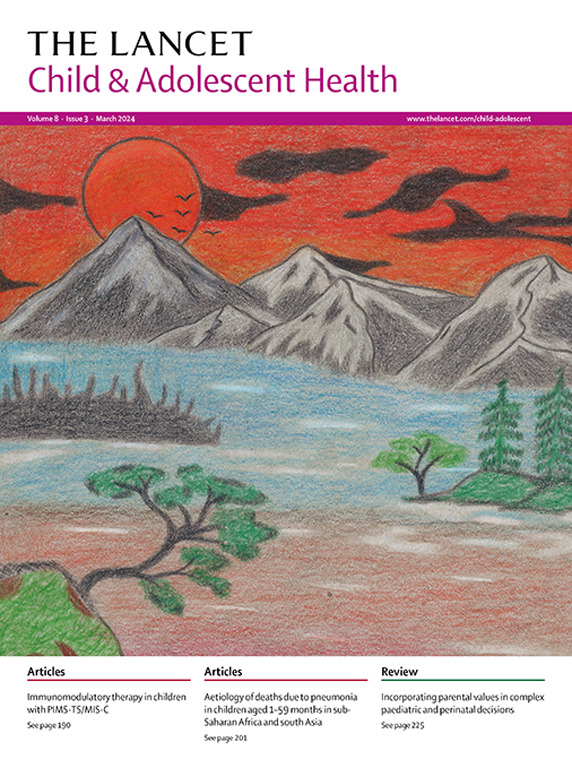Universal newborn screening for congenital cytomegalovirus infection
IF 19.9
1区 医学
Q1 PEDIATRICS
引用次数: 0
Abstract
Congenital cytomegalovirus (CMV) infection is the leading infectious cause of childhood disability, in particular sensorineural hearing loss (SNHL). Timeliness of diagnosis is crucial, since the presence of CMV in any compartment (eg, blood, urine, or saliva) after age 21 days can mean postnatal acquisition of infection, particularly in breastfed infants. Given these issues, there is considerable interest in implementation of screening programmes—either universal screening (where all newborns are tested) or targeted screening. Targeted screening is typically based on the outcome of a newborn hearing screen, and can be influenced in some strategies by findings of other signs suggestive of congenital CMV. Universal screening is likely to have the greatest overall benefit. Early identification of congenital CMV allows for interventions such as antiviral therapy (when indicated) and enables anticipatory audiological monitoring that facilitates timely detection of delayed-onset SNHL. However, there are debates about the effectiveness of screening programmes. Most infants with congenital CMV are unaffected and do not appear to be at risk for adverse neurodevelopment outcomes, except for SNHL. Screening can, therefore, raise unwarranted concern among parents and clinicians in these cases. The best clinical sample for diagnostic testing is unclear. PCR testing of saliva is sensitive but has a risk of yielding false-positive results in infants without congenital CMV. Resolving the technological issues has improved the sensitivity of dried blood spot (DBS) PCR but the technique remains suboptimum. An advantage to DBS PCR testing is that an infrastructure exists to add this test to existing newborn screening programmes. In this Review, the advantages and disadvantages of congenital CMV screening are discussed, along with high-priority areas for future research that will inform and direct this rapidly evolving field.
新生儿先天性巨细胞病毒感染的普遍筛查
先天性巨细胞病毒(CMV)感染是儿童残疾的主要感染性原因,特别是感音神经性听力损失(SNHL)。诊断的及时性是至关重要的,因为21天以后在任何细胞间(如血液、尿液或唾液)出现巨细胞病毒可能意味着产后感染,尤其是母乳喂养的婴儿。鉴于这些问题,人们对实施筛查计划非常感兴趣——无论是普遍筛查(对所有新生儿进行检测)还是有针对性的筛查。有针对性的筛查通常是基于新生儿听力筛查的结果,在某些策略中,可能会受到提示先天性巨细胞病毒的其他迹象的影响。全面筛查可能具有最大的总体效益。先天性巨细胞病毒的早期识别可以进行干预,如抗病毒治疗(如有指征时),并可以进行预期的听力学监测,从而有助于及时发现延迟性SNHL。然而,关于筛查项目的有效性存在争议。大多数患有先天性巨细胞病毒的婴儿不受影响,似乎没有不良神经发育结果的风险,SNHL除外。因此,在这些病例中,筛查可能会引起家长和临床医生不必要的担忧。诊断测试的最佳临床样本尚不清楚。唾液的PCR检测是敏感的,但在没有先天性巨细胞病毒的婴儿中有产生假阳性结果的风险。技术问题的解决提高了干血斑PCR (DBS)的灵敏度,但该技术仍处于次优状态。DBS PCR检测的一个优点是,现有的基础设施可以将这种检测添加到现有的新生儿筛查规划中。在这篇综述中,讨论了先天性巨细胞病毒筛查的优点和缺点,以及未来研究的重点领域,这些研究将为这一快速发展的领域提供信息和指导。
本文章由计算机程序翻译,如有差异,请以英文原文为准。
求助全文
约1分钟内获得全文
求助全文
来源期刊

Lancet Child & Adolescent Health
Psychology-Developmental and Educational Psychology
CiteScore
40.90
自引率
0.80%
发文量
381
期刊介绍:
The Lancet Child & Adolescent Health, an independent journal with a global perspective and strong clinical focus, presents influential original research, authoritative reviews, and insightful opinion pieces to promote the health of children from fetal development through young adulthood.
This journal invite submissions that will directly impact clinical practice or child health across the disciplines of general paediatrics, adolescent medicine, or child development, and across all paediatric subspecialties including (but not limited to) allergy and immunology, cardiology, critical care, endocrinology, fetal and neonatal medicine, gastroenterology, haematology, hepatology and nutrition, infectious diseases, neurology, oncology, psychiatry, respiratory medicine, and surgery.
Content includes articles, reviews, viewpoints, clinical pictures, comments, and correspondence, along with series and commissions aimed at driving positive change in clinical practice and health policy in child and adolescent health.
 求助内容:
求助内容: 应助结果提醒方式:
应助结果提醒方式:


